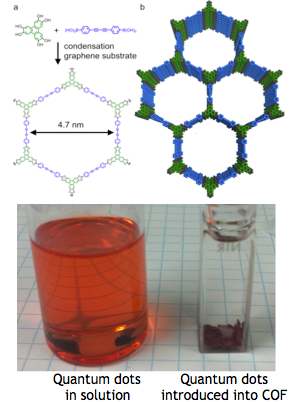 Designable Porous Organic Networks Represent A New Strategy for Nanoparticle Assembly
Designable Porous Organic Networks Represent A New Strategy for Nanoparticle Assembly
Ultrasmall semiconductor particles, so-called “quantum dots,” have tunable optical and electronic properties that derive from their nanometer-scale size. Scientists have long hypothesized that ordered arrays of nanoparticles with precisely controlled spacing will have enhanced properties that are ideal for a variety of applications, including the production of high efficiency solar cells. The challenge has been assembling millions of tiny dots in the desired structures.
Researchers at Cornell have developed a method that uses covalent-organic frameworks (COFs) — huge organic molecules that resemble nm-size honeycombs — to create ordered arrays of quantum dots. In the absence of the honeycomb, the 3-nm-diameter quantum dots float freely in solution, leading to a pronounced orange color (image at right). When honeycombs (COFs) are dropped into the beaker, the quantum dots spontaneously file into the nm-scale openings where they become trapped in the 4.7 nm hexagonal pores. As a result, the orange color in solution quickly fades. The honeycombs, however, take on a deep red color consistent with correct ordering of the dots. This finding may enable the development of high performance hybrid materials for solar cells.